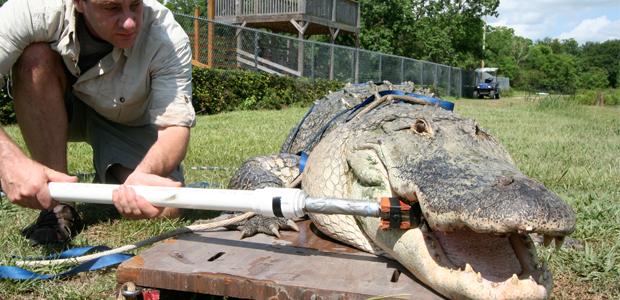A team of researchers from the United States and Australia have measured the bite-force and tooth-pressures in all 23 living species of crocodilians – including alligators, crocodiles, caimans and gharials.
A saltwater croc – known as Crocodylus porosus – in Australia has decimated the record for largest bite-force ever measured in an animal.
Nearly four times greater than the previous record – set by a spotted hyena – the chomp was more than 3,500 pounds and practically equivalent to bench-pressing a midsize car – like the Chevy Volt.
“I’d love to see what a sperm whale or a killer whale could do,” Gregory M. Erickson, lead study author and Paleobiologist at Florida State University, told Science-Fare.com. Clearly, logistics are the only thing keeping Erickson from taking those measurements too – take a look at how close he got to measure that croc’s bite-force!
This is just one of many cool things a team of researchers from the United States and Australia have learned after measuring the bite-force and tooth-pressures in all 23 living species of crocodilians – including alligators, crocodiles, caimans and gharials.
What drives bite-force in crocodilians, researchers say, is their size – with 85 million years of evolution to refine it.
“Very early in their evolutionary history, they seized on a very good design for extremely high bite-force production,” Erickson said.
All living species had bite-forces that could crush bone too. In fact, eight of the species each had at least one croc that broke the previous record for highest bite-force ever measured – albeit marginally in some cases.
The researchers say crocodiles with slender snouts – known as rostra – were able to pack the same wallop, pound-for-pound, as their robust snouted relatives.
“Animals with skinny snouts are eating more complaint prey, so they don’t break their jaws,” Erickson said. “Even though they have the high bite-force, they’re not loading the jaws up to a great extent.”
“That’s what’s allowed them to exploit the kinds of prey that are common at the water’s edge,” he added.
The tooth-pressures measured were equally staggering too – they were also just as varied in shape.
The highest one recorded was by Crocodylus intermedius at a little more than 200,000 pounds per square inch – a pressure nearly enough to create a diamond and far exceeds what any human could do.
“By playing around with the tooth form, they change the tooth pressures and all of a sudden they can feed on something else,” Erickson said. “Evolution was playing around with the snout form, tooth types and the body size independent of each other.”
Along with impressive bite-forces, the researchers collected enough data to create a reliable model – which is apt since one species of croc actually registered a bite-force that was nearly ten times higher than predicted by current modeling!
“Now, we’ve got a quantitative, empirical foundation for what these animals can really do – what an anatomist would call performance,” Erickson said. “From that we can build better models and better understand how the systems work.”
It also allows researchers to predict the bite-force of larger, wild and extinct crocs. With some saltwater crocs known to be as long as seven metres, the researchers say they could have had bite-forces as high as 7,736 pounds, while an 11 metre long extinct crocodilian species – known as Deinosuchus riograndensis – could have packed a wallop that’s more than 23,000 pounds.
“That’s twice the recent estimates for what T-Rex could do,” Erickson said.
What’s also cool, is how many different types of researchers were brought together to carry out the experiments – even the tools needed to record the bite-forces had to be custom manufactured.
“It’s kind of like dragon-slaying by committee,” Erickson said. After an expert helps determine the best way to catch the crocodilians – without causing unnecessary stress or harm – it took a team of engineers, statisticians and other biologists to carry out and analyze the measurements they recorded.
Fortunately, every species of croc was easier to track down and test – there’s only one place worldwide that’s got every species on display. It’s made even easier when the owner’s an engineer who encourages crocodilian conservation.
“When I talked to him about doing this research, he was sort of intrigued because he likes engineering,” Erickson said. “He not only endorsed it, but he gets it and that’s neat.”
“It’s not like one of those alligator wrestling places you see down in south Florida – it’s a very professional outlet in that sense,” he added.
The research was published in the journal PLoS One.
Create an account so you can engage in the conversation – we’d love to hear from you!
Science Fare Media’s new! Check out our Facebook page and tell your friends!
Follow us on Twitter @ScienceFare
 Science Fare Media Science News – Upgraded
Science Fare Media Science News – Upgraded


